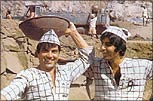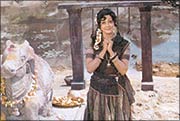

| February 7, 2001 | 
|
HOME | MOVIES | MEMORIES | |||||
|

|
'I didn't even know there was another ending to Sholay'
Sholay. Who doesn't remember the movie? Perhaps every Indian knows the on screen saga. Now, the off screen story is chronicled in Sholay - The Making of a Classic. Be it Amitabh Bachchan's struggle to convince the Sippys to choose him, the romance between Hema Malini and Dharmendra or Amjad Khan getting the Gabbar Singh role after Danny Dengzongpa's exit, the book tells it all. Entertainment Correspondent Ronjita Das discussed the book with author Anupama Chopra. What inspired you to write this book? Actually, it wasn't my idea. Sheena, Sonya and Rohan, Ramesh Sippy's children, wanted to commemorate the silver jubilee of Sholay, which was on August 15, 2000. For this purpose they wanted a book written on it. My brother (novelist Vikram Chandra) is a friend of theirs. So, he asked me to do it. I can't really take the credit because the idea was theirs. Were there any obstacles while writing the book? There was only one major obstacle.
Otherwise, the book progressed quite smoothly. Everyone was most co-operative. The main reason behind the co-operation I received was because the book was done along with the Sippys. It is a film that means so much to everybody. We met everyone right from the cook to the operative cameraman. Their office helped me to trace people whom I couldn't have found on my own. In fact, some of the assistants who worked for Sholay are still around. They helped me seek out the people who had retired. My only regret is that I can't imagine what it would have been like if Amjad Khan, Sanjeev Kumar and Dwarka Divecha were still alive. It would have added a whole new dimension to the story, as their contribution was really critical in how the film shaped up. How did you counter this obstacle? I spoke 'around' them. I guess that's what journalism is about. Since Dwarka Divecha wasn't there, I spoke to Anwar, the operative cameraman at that time. They had worked very closely. He knew exactly how Divecha's mind worked. I also spoke to a relative, Kanan Divecha. I spoke to a number of people who were in the same field as Divecha, and who had worked with him. For Amjad Khan, I spoke to his wife. She was so co-operative that she even hunted for the letters he had written to her, when they were shooting in Bangalore! How did you structure your book?
I structured it chronologically. I have started the book with the party, where the casting was being decided, and everything was up in the air. I wanted to add a lot of colour to the story. I have dedicated one entire chapter to action, because I feel action played a very crucial role in the film. Sholay had its ending changed because the Censor Board didn't agree to its original ending. You have seen the original ending. Can you tell us something about it? That was such a surprise! I didn't even know there was another ending to the film. I was watching the ending of the film, expecting the cops to rush in any moment and stop the Thakur from beating Gabbar Singh. But that doesn't happen! The Thakur keeps hitting Gabbar with his feet, wearing shoes that have nails fitted in the soles. It is a stunningly done sequence, because the Thakur just crushes Gabbar, like a snake, and kills him. Then he breaks down and cries. This is the first time you see the Thakur crying in the film. And it does convey a sense of loss. I mean, the message is not that good has won over evil, but that violence doesn't pay for anyone. Both men have lost so much it's really not a victory that can be celebrated, because it was so tragic for everybody. To me, it made so much more sense than the silly policemen who came rushing in at the end. The scene is touching also because you never see the Thakur breaking down. You always see him standing with his shawl and his stern gaze. Then he just drops down and weeps. It was an amazing scene. Who were the key people you spoke to?
Rohan, Sonya, Sheena and I sat down and made a list of all the primary, secondary and smaller players in the making of this film. Ideally, I would have also liked to go to Bangalore and find the locals who had worked on it, because there were a lot of people around the area, who worked as labourers. But book writing doesn't have the budget to do that! How did you choose the people you wanted to talk to, who are in no way connected to the film? I have spoken to people like Ramgopal Varma, who I know, have been very influenced by this film. Being a director, he would have some insights into the film. I also spoke to Atul Dodiya, the painter, who painted a portrait of Amjad Khan, as Gabbar Singh. The coffee table version of the book will be out in February. So a lot of the illustrations will appear there. Originally, we had planned to do a chapter called 'Voices' which spoke about how the film has influenced people. But it didn't fit right, so we didn't add it. How did your brother help you in writing this book?
What about your husband (director Vidhu Vinod Chopra)? Did he help you in writing the book? (laughs) Oh! Not at all! He wasn't involved at all. But I suppose, he played the most critical part as he supported me while I was doing something that doesn't pay at all! Writing books in India is really a labour of love. But, of course, putting food on the table means a lot. I mean, if I didn't have him, then I wouldn't be able to take five months off from my job, to write a book. He provided the financial support! What is your next project? I am having a baby! So that's the next immediate project! I will be having a baby in May. ALSO READ:
ALSO SEE:
Do tell us what you think of this interview
|
 The fact that three vital pillars of Sholay -- actors Amjad Khan, Sanjeev Kumar and cinematographer Dwarka Divecha -- are no longer alive.
The fact that three vital pillars of Sholay -- actors Amjad Khan, Sanjeev Kumar and cinematographer Dwarka Divecha -- are no longer alive.
 My aim was to tell a good story. I don't think people want to read something that's not interesting. No one has time anymore. There has to be an element of storytelling and entertainment. If the book is even half as good as the film, I will have accomplished a lot!
My aim was to tell a good story. I don't think people want to read something that's not interesting. No one has time anymore. There has to be an element of storytelling and entertainment. If the book is even half as good as the film, I will have accomplished a lot!
 I spent hours talking to Ramesh Sippy. I also wanted to find out who he really is. He was in his 20s when he made this film. We talked in great detail. Of course, even the writers -- Javedsaab and Salimsaab. They are such great storytellers. These three were the main people who I kept going back to, as they were there from the very beginning. The four-line idea started with these three. And then, of course, the actors. I even spoke to the driver of the train, which crashes into those logs!
I spent hours talking to Ramesh Sippy. I also wanted to find out who he really is. He was in his 20s when he made this film. We talked in great detail. Of course, even the writers -- Javedsaab and Salimsaab. They are such great storytellers. These three were the main people who I kept going back to, as they were there from the very beginning. The four-line idea started with these three. And then, of course, the actors. I even spoke to the driver of the train, which crashes into those logs!
 He was the first reader and editor of my book. I would send him chapters of my book, as soon as I had written it, and he would comment on it. I was really nervous about that, as I have a lot of regard for his writing, and my writing seems so chalu in front of his! But he really enjoyed it. He played the role of a first editor. We both believe in good story telling. So I thought if I could hold his interest, then it would work for other people as well.
He was the first reader and editor of my book. I would send him chapters of my book, as soon as I had written it, and he would comment on it. I was really nervous about that, as I have a lot of regard for his writing, and my writing seems so chalu in front of his! But he really enjoyed it. He played the role of a first editor. We both believe in good story telling. So I thought if I could hold his interest, then it would work for other people as well.